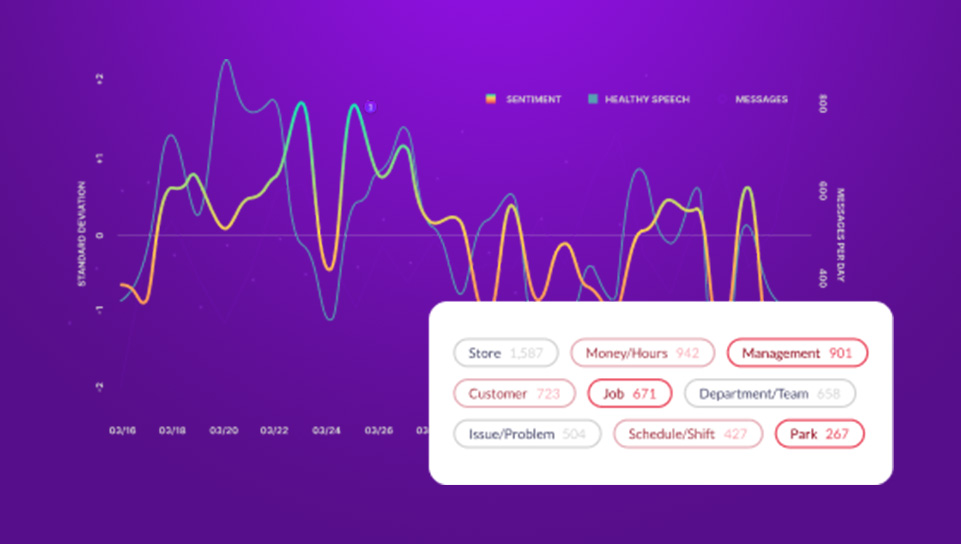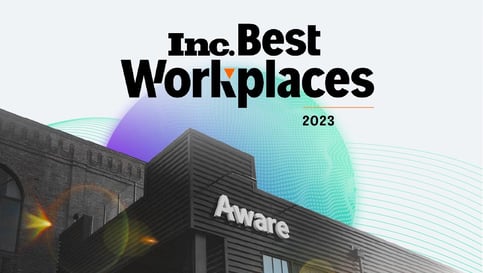Managing the Chaos of Collaboration in the Digital Workplace
by Aware
What is collaboration? In a safe and innovative workplace, it’s where content, conversation, and people come together. But increased collaboration brings with it new risks and a whole lot of noise. Aware helps organizations make sense of that noise, manage the data, control the risk, and capture valuable authentic insights that drive progress. Aware’s Head of Customer Success Kaitlyn Debelak and Product Evangelist Chris Plescia sat down to talk about the new challenges posed by collaboration in the digital workplace. Learn how AI-enriched data governance technology from Aware is changing the way organizations control the chaos of collaboration.

Watch the full presentation now or continue to the recap below.
Collaboration: The Future of Work
Between 2019-2021, the use of collaboration tools increased by 44%. Today, almost four in five organizations rely on collaboration tools to keep work on track. That's not surprising given almost 70% of full-time workers went remote during 2020. This is a big shift from pre-pandemic days, when less than 3% of the U.S. population worked remotely.
While tools such as Slack, Microsoft Teams, Yammer, and Workplace from Meta had been growing steadily, 2020 was a banner year for collaboration. Organizations were forced to accelerate adoption of new tools, without establishing the checks and balances needed to safeguard their data and protect employees.
Collaborative tools have reinvented the way the workforce communicates. Gone are the days of logical email chains. In their place are fragmented conversations split between public and private forums. Instead of structure there are acronyms, gifs, and emojis. In place of labeled attachments are a mountain of audio, image, and video files.
How do organizations make sense of this data? And how do they monitor and protect it?
What’s certain is there’s no going back. Collaboration is the future of work. Almost half of workers said they’d leave a position if they lost the option to work remotely. And a massive 81% of U.S. workers who went remote during the pandemic said they want to keep a remote or hybrid position in the future. That means organizations need to address shortcomings in their collaboration and find new ways to take control of their data.
The 5 Pillars of Collaboration Management
At Aware, we’ve identified five key disciplines needed to manage collaboration and put organizations back in the driving seat. Collectively, these disciplines return control of collaboration data to the organization and establish new practices for monitoring and moderating collaborative data in the evolving digital workplace.
ADOPTION
Understanding and managing collaboration data starts with looking at how collaboration works. What tools has the company provided, and what solutions have employees brought into the mix? How do companies validate that an investment was successful? Adoption is the very foundation of the ability to implement different tools, establish how they’re used, and start taking control of them.
SEARCH AND DISCOVER
Are organizations able to use the data they’re creating? Is it possible to filter messages and understand their context? eDiscovery results rarely make sense in a vacuum, and modern collaboration has come a long way from emails that formalize senders, recipients, and content. How is data categorized and tabulated to facilitate search functionality?
REALTIME MONITORING AND MODERATION
With the right checks and balances in place to control data, organizations can use AI to monitor collaboration in real time. Making the switch from reactive to proactive data management strengthens security protocols and reduces the impact of breaches. Infusing AI into real-time monitoring can also highlight blind spots and compensate for human error in data security.
DATA MANAGEMENT
How does an organization delete or quarantine collaboration data? Data is being created constantly, so there must be protocols in place to define what to do with it. AIML can create workflows to appropriately manage data, flag risks, and even capture breaches before they occur.
PEOPLE INSIGHTS
Are managers authentic listeners or casual lurkers? You can’t delegate empathy, but you can use AI-enhanced insights to understand authentic sentiment in the workforce. By monitoring ongoing collaboration, rather than relying on pulse surveys, organizations can understand the drivers of employee interactions and make strategic, insightful decisions about the future of the company.
Final Thoughts
Using the right collaboration management tools, IT and Information Security teams can drive the security and culture of an organization and lead them proactively into the digital realm. Focusing on these five pillars helps unleash the power of collaboration and deliver a return on investment, and a return on your people.








